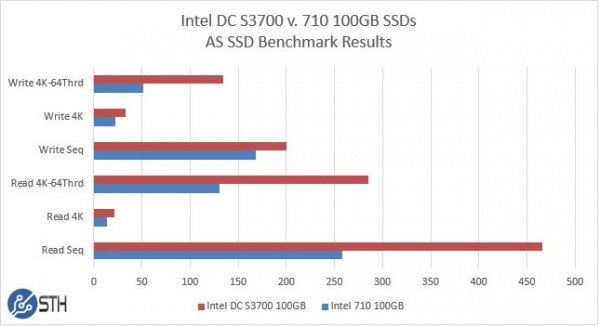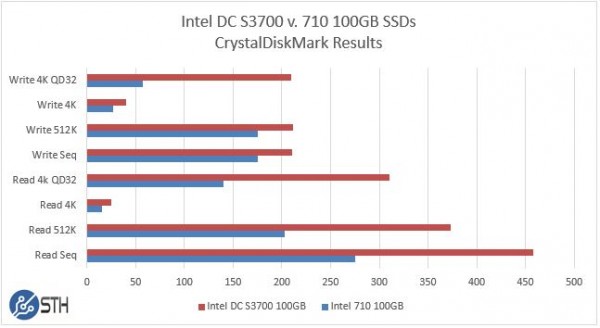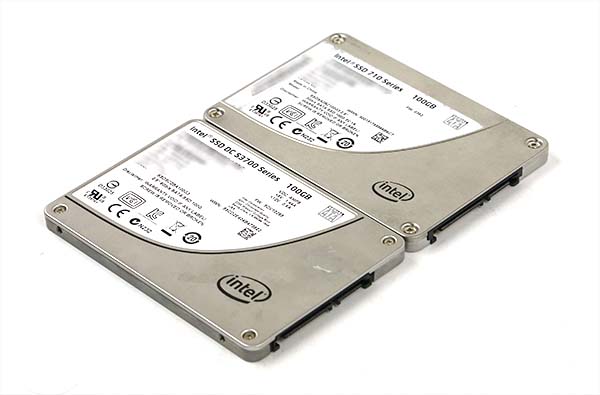Today we are comparing quick benchmark results of the Intel 710 100GB SSD and the Intel S3700 100GB SSD. It is little secret that Intel has an excellent reputation for making reliable drives. Both drives utilize eMLC for solid write endurance. They both have power loss protection as they are aimed at datacenters. Likewise, both use Intel controllers with Intel firmware designed for enterprise workloads. 100GB drives these days are rather tiny, but they are perfect for applications such as running Hyper-V or a base Linux installation while having plenty of space leftover for an extra partition, space for upgrades and etc. The Intel 710 100GB was a SATA II generation drive that cost $650 when it came out in 2011. The Intel S3700 100GB launched in Q4 2012 has a recommended price of $184. For reference, we got the Intel 710 100GB we used in this review for $40 off of ebay with 8 hours used and 3GB written and the S3700 for $90 and a similar level of “wear”. Suffice to say, we are not expecting extreme performance here, but there is merit to inexpensive and reliable drives.
Test Configuration
Since we are going to assume the use of already released hardware, we are using a legacy system for testing across the test suite:
- Motherboard: Gigabyte GA-7PESH3
- Processors: Dual Intel Xeon E5-2690 (V2)
- SAS Controller: LSI SAS 3008
- RAM: 64GB DDR3L-1600MHz ECC RDIMMs
- OS SSD: Kingston V300 240GB
We are using the same test configuration as we did with our SAS SSD tests. It should be noted that these drives will work on the onboard Intel SATA controller but we wanted to present a different view of their performance by using the SAS controller. We bought our own drives for benchmarking. This is not an Intel sanctioned benchmark session. Each of these drives endure over a full 24 hours of total testing time after a secure erase, so these are certainly far from “fresh out of the box” performance figures.
Intel 710 100GB v. Intel DC S3700 100GB Quick Benchmarks
For our quick tests during this part of the series we will just provide the quick benchmarks with only a bit of commentary. We fully expect the S3700 to be much faster but there is little data on the smaller capacity drives.
AS SSD Benchmark
AS SSD is a solid benchmark that does not write compressible data to drives. The result is perhaps one of the best workstation SSD benchmarks available today.

These tests are in MB/s. One can see that the 4K and sequential write results are fairly close. On the other hand, the read results and higher-queue depth operations clearly favor the Intel DC S3700.
CrystalDiskMark
CrystalDiskMark is another benchmark which gives non-compressible read/write numbers. This is in contrast to the ATTO Benchmark used by LSI/ Sandforce and its partners when they market a given solid state drive.

Looking to Crystal Disk Mark, we again see that on the write side of the equation, the S3700 only pulls (significantly) further away at 4K high queue depth operations. On the read side, the Intel DC S3700 is using a SATA 3 bus so speeds are understandably better.
ATTO Benchmark
The value of the ATTO benchmark is really to show the best-case scenario. ATTO is known to write highly compressible data to drives, which inflates speeds of controllers that compress data like LSI/ SandForce does prior to writing on a given solid state drive.
We broke results into two tables. Write speeds and Read speeds. The y-axis is test size and the x-axis is KB/s.

The pattern we saw with the write results in AS SSD and CrystalDiskMark continues here. The Intel 710 is somehow pulling ahead in very small transfers while by 4K we see the S3700 take a lead. That lead is not commanding. One might wonder if Intel tuned the S3700 slightly for 4K operations.

On the ATTO read side we again see the Intel 710 pull ahead at small transfer sizes. The SATA 2 to SATA 3 transition clearly helps the S3700 as the 710 is hitting an interface speed wall.
Conclusion
It turns out, the Intel 710 100GB drives are easy to find at inexpensive pricing. Commonly they pop up on ebay for $40-80. The S3700 is less plentiful right now and costs more. Given the choice between one S3700 100GB or two Intel 710 100GB drives, the 710 option looks attractive. Performance wise, one must remember that in servers with gigabit Ethernet connections, there is a practical speed limit for downloads to around 125MB/s. For OS drives, faster is better however both drives should perform well enough for the task. The advantage of purchasing one of these drives over a used consumer drive is that these have higher write endurance and are less likely to have wear indicators higher in the spectrum. On the other hand, larger drives are generally better so the 200GB and above options are extremely attractive.




